Standing in the heart of Padua, Italy, I felt my breath catch as I entered the modest Scrovegni Chapel. What appeared simple from the outside opened into a world of breathtaking artistry that has influenced Western art for centuries.
Giotto’s frescoes in the Scrovegni Chapel represent one of the most complete and revolutionary artistic achievements of the early Renaissance. The 38 scenes depict biblical stories with unprecedented realism and emotional depth.
The chapel’s walls glow with a vibrant azure blue, creating a heavenly backdrop for Giotto’s masterful storytelling. What struck me most was how human the figures appeared – showing real emotions and natural poses unlike anything created before the 14th century.
I stood mesmerized beneath the golden stars on the ceiling, slowly taking in each scene of Christ’s life and the Virgin Mary’s story.
Many visitors don’t realize that these remarkable frescoes were completed in just two years – an astounding achievement considering their detail and scale. The careful restoration work has preserved Giotto’s original vision, allowing us to experience these images much as viewers did seven centuries ago.
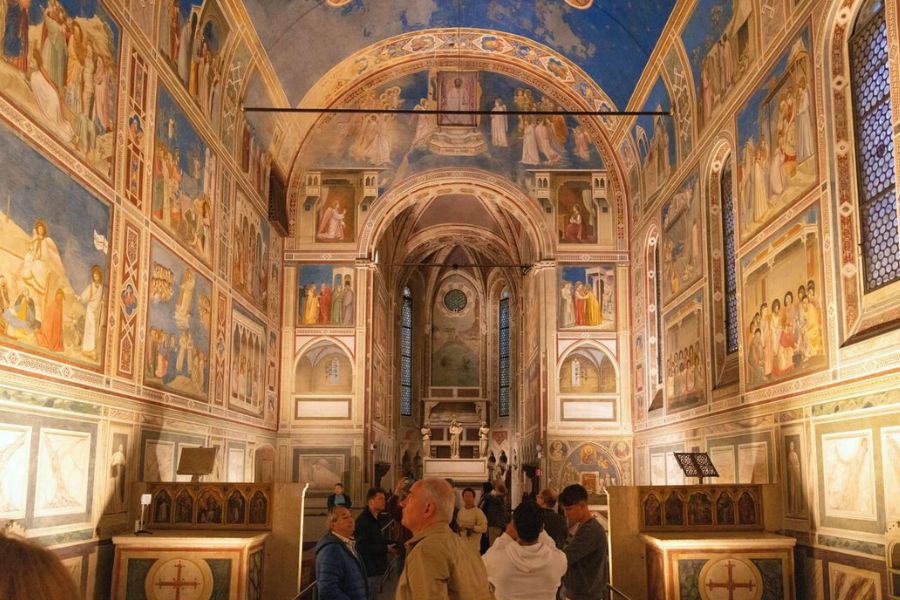
My time was limited to just 15 minutes inside (a preservation measure), but those moments changed how I understand the evolution of Western art forever.
Discovering Giotto: The Master of Frescoes
Standing in the Scrovegni Chapel, I felt transported back to the dawn of Renaissance art. Giotto’s frescoes here represent not just beautiful paintings, but a revolutionary approach to art that changed Western painting forever.
Who Was Giotto Di Bondone?
Giotto di Bondone emerged in the late 13th century as a groundbreaking artist who challenged the rigid Byzantine style of his time. Born around 1267 near Florence, he transformed art by introducing naturalism and emotional depth previously unseen.
What makes Giotto special is how he depicted human figures with weight, volume, and genuine emotion. Before my visit to Padua, I’d only seen his work in textbooks. Nothing prepared me for seeing his use of perspective in person, especially remarkable considering he worked two centuries before formal perspective rules were established.
His technical innovations paired with storytelling abilities made him the most sought-after artist of his day. Giotto’s influence spread throughout Italy, inspiring generations of artists who would eventually lead to the Renaissance.
The Evolution of Fresco Techniques
Giotto revolutionized fresco painting in the early 14th century. Traditional frescoes before him appeared flat and symbolic, but his work in the Scrovegni Chapel demonstrates remarkable technical advancements.
The “buon fresco” technique he mastered involved applying pigment to wet plaster, creating a chemical bond that preserved colors for centuries. I was amazed at how vibrant the blues remain after 700+ years!
His innovative approach included creating depth through architectural elements, using shadows to model figures, employing naturalistic gestures and expressions, and developing narrative scenes that flow together.
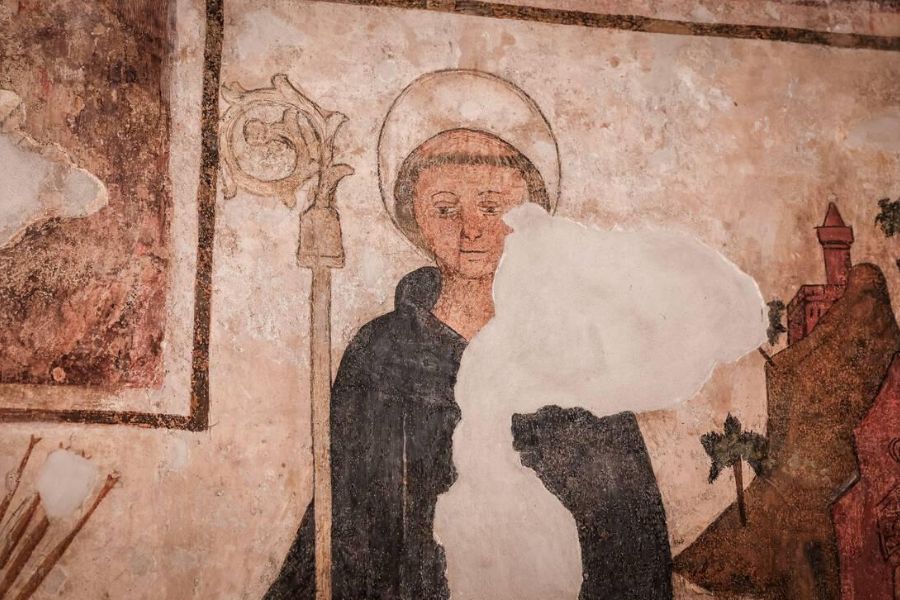
Walking around the chapel, I noticed how he painted the entire space as a unified whole rather than disconnected scenes. This comprehensive approach transformed the chapel into an immersive experience that still moves visitors today.
A Journey to Padua’s Architectural Gem
Tucked away in the historic city of Padua sits one of Italy’s most precious artistic treasures. The Scrovegni Chapel stands as a testament to both religious devotion and artistic innovation, drawing visitors from around the world to witness its remarkable frescoes.
The Historical Significance of Scrovegni Chapel
The chapel was commissioned around 1303 by wealthy banker Enrico Scrovegni, possibly as an act of atonement for his father’s sin of usury. This small building holds enormous historical weight in the art world.
When I learned that Giotto’s work here helped bridge medieval art to the Renaissance, I knew I had to see it firsthand. The chapel stands on the site of an ancient Roman arena, which explains its alternative name: Arena Chapel.
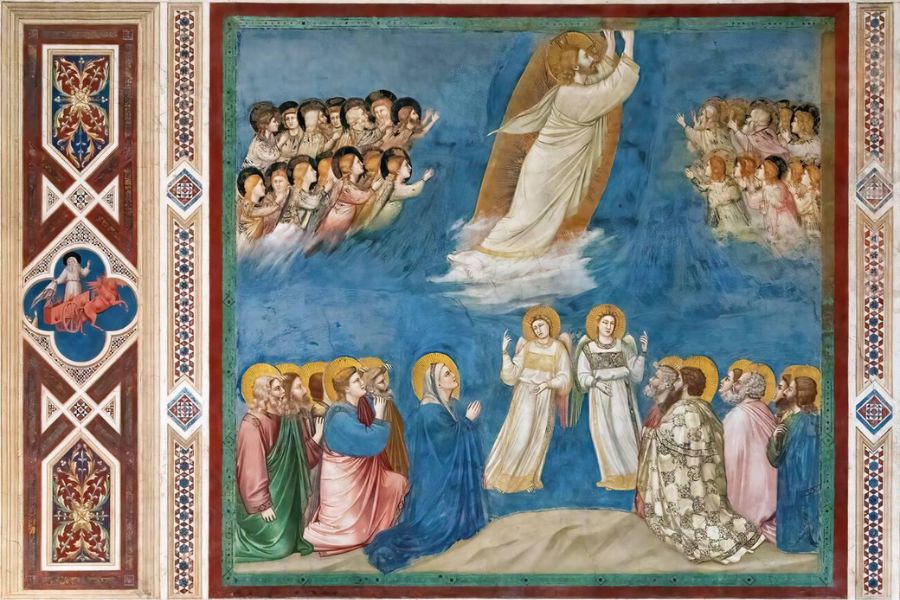
What struck me most was how these 700-year-old frescoes still look remarkably fresh and vibrant. The preservation efforts have been extraordinary, including the 15-minute “environmental equilibration” chamber visitors must pass through before entering.
The Architectural Marvel of the Arena Chapel
The chapel’s simplicity is part of its genius. Its rectangular structure with a barrel-vaulted ceiling creates the perfect canvas for Giotto’s masterpieces.
When I stepped inside, I was immediately surrounded by color on all sides. The vibrant blue starry ceiling contrasts beautifully with the narrative scenes covering the walls. Every inch tells a story.
The architectural design cleverly maximizes natural light through six narrow windows along the southern wall. This illumination brings the frescoes to life in stunning detail.
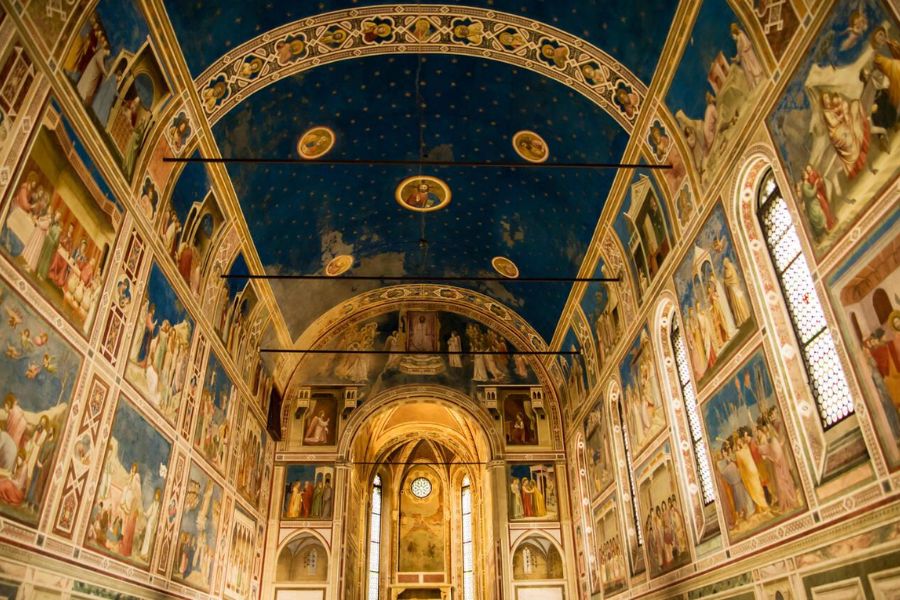
The visit is meticulously organized. I appreciated the introductory video that prepared me for what I was about to experience. Nothing compares to standing in this space where art, architecture, and spirituality merge so perfectly.
The Visual Symphony of the Scrovegni Chapel Fresco Cycle
Walking into the chapel, I was immediately enveloped by a sea of vibrant blues, reds, and golds. Giotto’s frescoes don’t merely decorate the walls—they transform the entire space into a narrative that flows seamlessly from panel to panel.
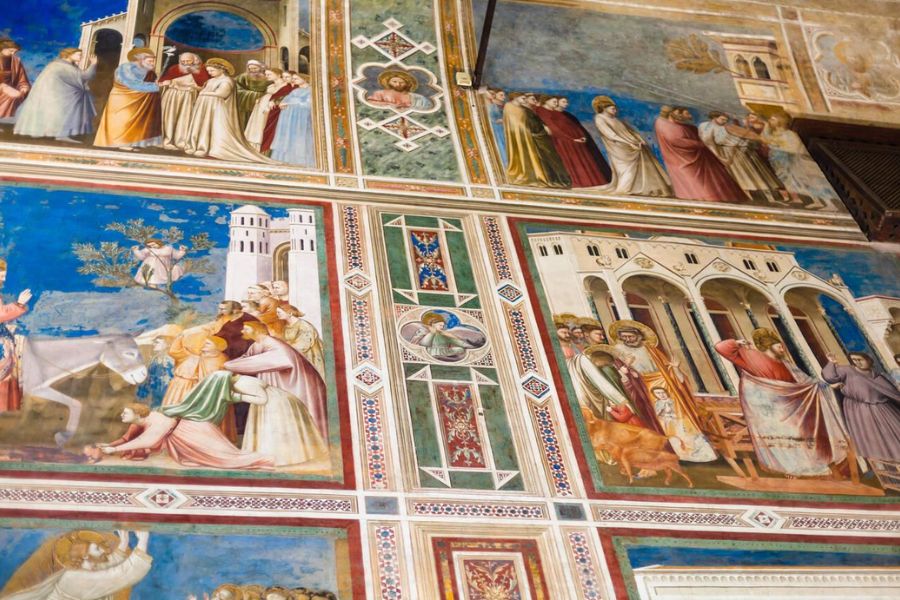
Exploring the Iconographic Program
The chapel’s walls tell a complete biblical story, organized in three tiers that I found surprisingly easy to follow. The top tier shows scenes from the lives of Joachim and Anna, Mary’s parents. The middle tier depicts the life of the Virgin and Christ’s childhood. The bottom tier portrays Christ’s ministry and Passion.
What struck me most was how Giotto arranged the frescoes to be “read” in a specific order. I started at the top right wall and moved left, then continued in a zigzag pattern downward. This thoughtful arrangement helps visitors follow the narrative chronologically.
The Last Judgment on the entrance wall is particularly breathtaking. Its scale and detail command attention immediately upon entering.
Giotto’s Fresco Cycle: A Theological and Artistic Analysis
The genius of Giotto’s work lies in how he revolutionized religious art. Unlike earlier medieval painters, he created figures with weight, emotion, and humanity. I noticed how characters in the frescoes actually look at each other, creating genuine human connections within the scenes.
The famous blue background (ultramarine derived from lapis lazuli) wasn’t just beautiful—it was incredibly expensive, showing Scrovegni’s wealth and commitment to the project.
Giotto’s innovative techniques are evident throughout. He created depth through architectural elements and positioning of figures. The Lamentation scene particularly moved me with its dramatic composition and emotional impact.
These frescoes represent a pivotal moment in Western art. Standing before them, I could see the seeds of Renaissance painting being planted in Giotto’s revolutionary approach to space, emotion, and storytelling.
In the Presence of a Masterpiece: A Personal Reflection
Standing in the Scrovegni Chapel, I was overwhelmed by the immediacy and power of Giotto’s work. The frescoes surrounded me completely, creating an immersive experience that connected me to art created over 700 years ago.
The Intimacy of Giotto’s Storytelling
What struck me most was how personal these biblical scenes felt. Giotto’s genius lies in making ancient stories feel immediate and human. The expressions on the faces in “The Betrayal of Christ” were so real I could almost feel Judas’s treachery.
Each narrative panel draws you in with its simplicity and emotional impact. I found myself lingering in front of “The Lamentation,” where Mary cradles her son’s body. The grief is palpable through Giotto’s masterful composition.
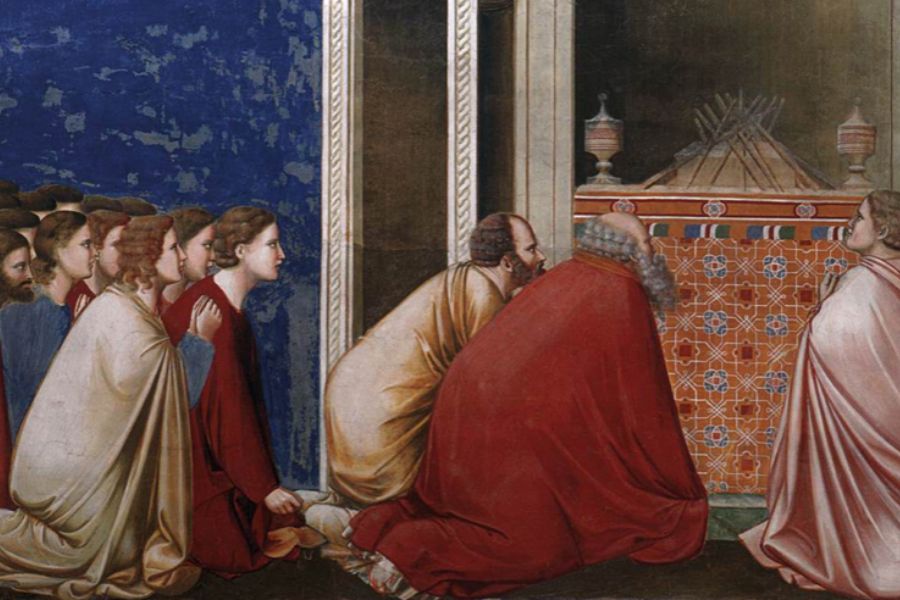
Unlike other chapels I’ve visited, the Scrovegni feels intimate. The relatively small space means you’re always close to the artwork, allowing you to notice small details like the delicate stars on the blue ceiling.
The Transformative Power of the Artwork
Time seemed to stop during my visit. What was scheduled as a 15-minute viewing stretched into nearly an hour as I circled the chapel repeatedly, discovering new details with each pass.
The vibrant blues used throughout the chapel create a sense of celestial wonder. These pigments, made from crushed lapis lazuli, remain brilliantly preserved despite the centuries that have passed.
The presentation of human emotions in these frescoes changed how I view religious art. Before visiting, I’d seen countless reproductions in books, but nothing prepared me for the emotional impact of seeing Giotto’s work in person.

There’s something transformative about being physically present with art of this significance. I left the chapel feeling genuinely moved, with a deeper appreciation for how revolutionary Giotto’s approach to painting was for his time.
Practical Tips for Visiting the Scrovegni Chapel
Booking tickets in advance is absolutely essential for the Scrovegni Chapel. I learned this the hard way after nearly missing my chance to see Giotto’s masterpiece in Padua.
The chapel is open daily from 9 AM to 7 PM year-round. Reserve your spot online through the official website at least a few days before your visit, especially during tourist season.
When you arrive, you’ll spend 15 minutes in an “environmental equilibration” chamber. This helps protect the delicate frescoes from temperature changes and humidity brought in by visitors.
Time Allocation:
- 15 minutes: Waiting room with video introduction
- 20 minutes: Inside the chapel (standard visit)
- 40 minutes: Inside the chapel (evening visits)
For serious art lovers, I highly recommend booking an evening visit. The extended 40-minute stay allowed me to fully appreciate the details of Giotto’s work, and the lighting created a magical atmosphere.
Audio guides are available on site. I found this essential for understanding the biblical scenes and artistic significance of what I was seeing.
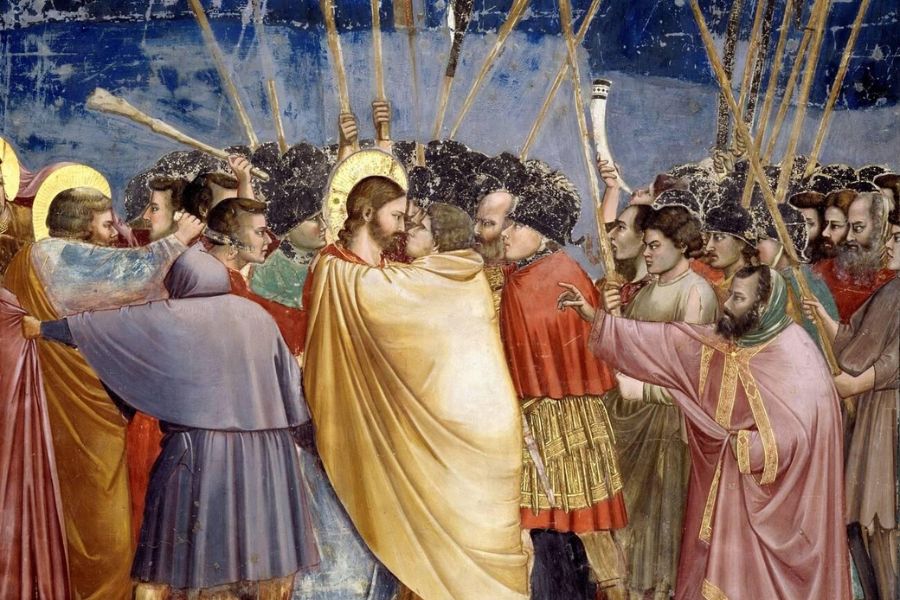
Don’t forget comfortable shoes! While the chapel visit itself isn’t strenuous, Padua has many other wonderful sights worth exploring afterward.
Photography is strictly prohibited inside to protect the artworks. Instead, I purchased a beautiful book from the gift shop as a memento of my visit to this remarkable Italian treasure.

